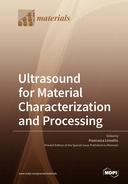Explore

Ultrasound for Material Characterization and Processing
0 Ungluers have
Faved this Work
Login to Fave
Ultrasonic waves are nowadays used for multiple purposes including both low-intensity/high frequency and high-intensity/low-frequency ultrasound. Low-intensity ultrasound transmits energy through the medium in order to obtain information about the medium or to convey information through the medium. It is successfully used in non-destructive inspection, ultrasonic dynamic analysis, ultrasonic rheology, ultrasonic spectroscopy of materials, process monitoring, applications in civil engineering, aerospace and geological materials and structures, and in the characterization of biological media. Nowadays, it is an essential tool for assessing metals, plastics, aerospace composites, wood, concrete, and cement. High-intensity ultrasound deliberately affects the propagation medium through the high local temperatures and pressures generated. It is used in industrial processes such as welding, cleaning, emulsification, atomization, etc.; chemical reactions and reactor induced by ultrasonic waves; synthesis of organic and inorganic materials; microstructural effects; heat generation; accelerated material characterization by ultrasonic fatigue testing; food processing; and environmental protection. This book collects eleven papers, one review, and ten research papers with the aim to present recent advances in ultrasonic wave propagation applied for the characterization or the processing of materials. Both fundamental science and applications of ultrasound in the field of material characterization and material processing have been gathered.
This book is included in DOAB.
Why read this book? Have your say.
You must be logged in to comment.
Rights Information
Are you the author or publisher of this work? If so, you can claim it as yours by registering as an Unglue.it rights holder.Downloads
This work has been downloaded 105 times via unglue.it ebook links.
- 105 - pdf (CC BY) at Unglue.it.
Keywords
- 1060 aluminum alloy
- 2A14 aluminum alloy
- axicon lens
- bulk metallic glass
- capillary penetration
- composite manufacturing
- composition segregation
- Concrete
- Creep
- cutting force
- damage identification
- early age
- elastography
- finite element analysis
- focused ultrasound
- guided waves
- heterogeneity
- L-shaped ultrasonic wave guide rod
- Lamb wave
- liquid composite molding
- liquid penetration
- material characterization
- Mechanical properties
- mesostructure
- Microstructure
- Monte Carlo method
- mortar and concrete
- n/a
- non-destructive inspection
- Permeability
- porous sheets
- Reinforcement
- resin transfer molding (RTM)
- resistance heating
- setting time
- SHM
- solidification structure
- stress relaxation
- Technology, engineering, agriculture
- Technology: general issues
- thermoplastic composites
- time of flight
- topology optimization
- transcranial ultrasound
- twin-roll casting
- ultrasonic assisted turning
- ultrasonic bending vibration
- ultrasonic joints
- ultrasonic lens
- ultrasonic visualization
- ultrasonic wave propagation
- ultrasound
- ultrasound transmission
- viscoelastic properties
Links
DOI: 10.3390/books978-3-0365-1709-4Editions

